

 |

|
The Concept of Life in Contemporary Japan
Masahiro Morioka
-- Japan Review vol.2 (1991):83-115 under the title “The Concept of Inochi: A Philosophical Perspective on the Study of Life.”
-- The Review of Life Studies Vol.2 (April 2012):23-62
Download [PDF]
The objective of this paper is to contribute to the international discussions on life and scientific technology by examining the images and concepts of life in contemporary Japan. In English the word Inochi can be rendered as "life". However, the nuances of the Japanese term differ in certain cases, and therefore I have chosen to use the term much as is. I first discuss the linguistic meanings of the word, and then consider several important features of the images of inochi that have appeared in publications and responses from questionnaires on this topic. Some philosophical and metaphysical interpretations of the concept of inochi are then proposed. Finally a brief outline of the study of life is presented, suggesting a new way to approach bioethics and discussions on environmental issues.
(Received 17 August 1990, accepted 1 November 1990)
Keywords: LIFE, SCIENCE AND TECHNOLOGY, MODERN CIVILIZATION, NATURE, JAPANESE THOUGHT, BUDDHISM, CONFUCIANISM, BIOETHICS, ENVIRONMENTAL ETHICS, HUMAN ECOLOGY, PHILOSOPHY, RELIGION.
*Page numbers in the original are marked by [(preceding page) / (following page)].
SCIENTIFIC TECHNOLOGY, LIFE, AND THE ENVIRONMENT
Modern civilization is characterized by industrialization and advanced scientific technology. It has developed through this century, and as a result, it has brought us great benefits and conveniences. However it is also true that it has caused a number of problems and crises concerning our attitudes toward life and the environment.
Today we face, on the one hand, global environmental issues such as the destruction of the ozone layer, and on the other hand, ethical problems arising from medical technology such as those associated with freezing early human embryos that are only a few cells. We should regard these problems as a set of interconnected ethical-social issues, because all these matters have been caused by the fundamental invasion of scientific technology into the realm of ‘life’ on this planet.
I have elsewhere advocated ‘the study of life’ as a comprehensive approach to all the problems arising from our attitudes toward life, the life of humans and of all other living creatures (1). From the viewpoint of the study of life, a number of ethical and social problems of our age can be discussed at the same time in the same way.
For example, environmental pollution caused by chemical factories, clearly apparent to Japanese people in the 1960’s (in the Minamata and other cases), was one of the first instances which indicated that the conduct of modern scientific and industrial civilization had done structural harm to human life and local ecosystems. The growing global environmental crisis became more apparent [83/84] through the 1970’s and 80’s, and has become one of the most important international political issues in the 1990’s. The main cause of the environmental crisis lies in the fact that the industrialized nations have underestimated the interrelatedness of our life and biosphere on this planet when making plans for their own industrialization and development (2). All forms of life on the earth, including humans and non-human organisms, constitute complicated and interrelated networks. Interrelatedness of this kind is one of the essential features of the images and concept of life (inochi) as we shall discuss later in this paper.
Let us consider the ethical issues arising from contemporary gene technology. Today we can easily cut and paste portions of the DNA sequence of organisms, including human beings, and then modify the genome of any organism using recombinant DNA techniques. The technology of genetic engineering has become the basic method for biological research in universities and corporations throughout the world. However, many ordinary people may remain unconvinced of the technology which might lead us to play the role of God. The inclination of scientific technology that seeks to deal with parts of a living creature as if they were parts of mere inorganic matter has made ordinary people hesitant to fully accept this technology. In other words, at the basis of these feelings, there are doubts about scientific technology in which life is considered to be merely like a mechanical clock. For people who have an organic or holistic view of the universe (3), life is a kind of self-organized system, which is born from the network of life, grows in relationships with other creatures, transforms its body and shape, gives birth to other life, and finally goes on to die. However, gene technology deals with DNA, the most fundamental part of a living cell, as if it were only part of an automobile or a bicycle. It is said that the principle of this technology was originally invented and developed in order to control the inorganic side of an object. This shows that one of the important ethical problems concerning biotechnology emerges between and organic-holistic view of life and mechanistic approaches in gene technology.
When scientific technology is applied to human life it can raise many other serious ethical and social problems. For example, we can fertilize ova and sperms in vitro outside the body (IVF), and then freeze surplus embryos, storing them for subsequent medical procedures for an infertile couple. Moreover, in many countries, we can scrap surplus embryos or use them for scientific and medical research within 14 days after fertilization. (In Britain embryos can be specifically made for research.) We can also inspect the DNA sequence and other important factors of embryos at their early stage, and destroy them if a serious defect is discovered. A fertilized embryo, even if it is frozen, has the potential to become a human person. However, that possibility disappears when we scrap [84/85] or make experimental use of it. How should we then evaluate the life of a human being who was conceived only to be a subject for medical research? Don’t we have to respect human life when it is at the very early stage (4)? Isn’t it just like playing the role of God (or the Devil) to perform the ‘selective disposal’ of defective embryos (5)? Here we encounter a collision between the nature of scientific technology and one of our basic traditional norms: ‘respect for life’ (6).
A number of ethical, social and religious problems have arisen simultaneously between life and scientific technology late in this century. These problems have been studied separately in several disciplines, such as bioethics, human ecology, medical anthropology, the philosophy and sociology of science, environmental ethics, and so on. However, I believe all these problems concerning life and scientific technology should be dealt with simultaneously and comprehensively in the same field, that is the study of life, because they share a fundamental background and several important questions, and because they are inseparably interconnected with each other.
Through the comprehensive study of life, we will be able to fundamentally criticize modern civilization which has been guided by science and technology. And we will also be able to seek new relationships between life and scientific technology which will never produce as many problems as they have in this century.
MEANINGS OF INOCHI IN MODERN JAPANESE
Before investigating the relationship between life and scientific technology, we first have to clarify what life is. However, this has been one of the most difficult questions humans have encountered, and no universally acceptable definite answer has appeared since the dawn of civilizations. Many religions have made clear the concept of life [85/86] within its own paradigm, and philosophers and biologists have defined it in their own ways. These definitions sometimes contradict each other. What is more important, traditional religious beliefs have not provided a world view powerful enough to elucidate the essence of today’s situations surrounding life. They have yet to explain, for example, the nature of industrialization and its effects on life; the meaning of the advanced nations’ affluent human life which has been brought about through the development of science, industry and imperialism; the historical meaning of global environmental crises in this century, and so on (7), (8).
What we have to do now is to seek a contemporary understanding of life which describes these situations broadly, can appreciate the fundamental significance of life, and will be accepted by a number of people with different cultures and religions.
As the first step toward this understanding, I have investigated images of life among modern Japanese people by using open questionnaires. In this paper, I will report on some of the main features of the images of life that appeared in the questionnaires and also in publications on life, and then advocate philosophical interpretations of the concept of life. There are few academic publications which deal with the concept of life (inochi) among modern Japanese. For example, Nakamura (1987) analyses the concepts of life, but mainly those which appeared in ancient Asian thoughts. The objective of this paper is to contribute to world-wide discussions on life and scientific technology by examining the images and concepts of life in contemporary Japan.
In modern Japanese there are two words, inochi and seimei, which are equivalent to the English word ‘life’. The word inochi (9) (pronounced ‘ee-know-chee’) is commonly used among ordinary Japanese when they refer to everyday phenomena concerning life, death, and nature, while the word seimei (10) does not enjoy such a wide use. Seimei is an academic word mainly used in the fields of biology, medicine, philosophy, and law. Historically speaking, the word seimei was rediscovered from old usages when [86/87] translating the European words ‘life’, ‘vie’ and ‘Leben’ in the Meiji era (19thcentury), and Japanese have accepted it as an academic and/or scientific term. The word inochi has a much longer history than seimei. This word is found in ancient literature such as the Man’yoshu and Kojiki (8th century). Inochi has become established as one of the most popular words in Japanese. Today even a primary school student knows the word inochi, but he/she doesn’t necessarily know the word seimei. Hence, when studying the images of life in contemporary Japan, it is the images of inochi that should be researched.
Inochi in modern Japanese has three linguistic origins, namely, Chinese, Buddhism, and ancient Japanese. Ming (11) in ancient Chinese corresponds to inochi. The original meaning of ming is to order someone to do something. The well known phrase tian ming (12) (man’s destiny determined by the transcendent being) is a derivation from this meaning. The ancient connotations of ming include ‘destiny’, ‘lifespan’ and ‘one’s nature’ which are determined in advance by the transcendent being.
The ming which appeared in Buddhist sutras written in Chinese characters has one other meaning: the energy or power of living. In fact, we can find in some sutras words that contain ming which stand for the principle or power that makes something alive from behind that being (13).
Inochi in ancient Japanese has meanings such as ‘lifespan’ and ‘the power of living’, because it had already been influenced by the meanings of ming imported from the Korean peninsula and China. The word inochi is considered to be made up of i and chi. The former stands for ‘breath’, and the latter stands for ‘inside’ or ‘dynamic energy’. Hence, inochi in ancient Japanese has, in addition to the above, the meaning of the dynamic energy of living in breath, which is equivalent to anima in Latin or psyche in ancient Greek, which is also a derivative of breath.
In modern Japanese, inochi basically has four meanings. The first meaning is the mysterious power or energy that keeps creatures and humans alive. For example, there are such expressions as ‘wash one’s inochi’ (14), which means the recovery of power that keeps us alive; ‘at the height of inochi’ (15), which means the peak of a creature’s life; and ‘burn up one’s inochi’ (16), which means to burn up one’s energy of living (and die). There is also the expression ‘to take over inochi from one’s ancestors’. This phrase means the succession of the dynamic power of living from generation to generation, rather than the succession of a living state. These meanings have a close relationship to the meaning of inochi as the energy of breath. On the one hand, breath makes an individual creature alive inside its body, but on the other hand, breath flows out of [87/88] an individual and then slips into another individual’s body. In this way, inochi, in the form of breath, incessantly interconnects all living creatures on the earth synchronically and diachronically.
The second meaning of inochi points to the period between birth and death, or the state of being alive. There are some expressions which stand for dying such as ‘inochi ends’, ‘lose one’s inochi’, and ‘drop one’s inochi’ (17). There are other interesting expressions such as ‘inochi shrinks’ (18), which means to encounter a danger; ‘one’s inochi is short’ (19), which means that there remains a short time until one’s death; ‘deposit one’s inochi with somebody’ (20), which means to leave one’s destiny under somebody’s control; and ‘pick up one’s inochi’ (21), which means to escape death accidentally. There are many more expressions that fall under this category in modern Japanese. At the root of all of these expressions there is an understanding that inochi is limited in time and space. In other words, inochi has its beginning and end, and thus an ‘inochi being (inochi arumono)’ must die sooner or later; at the same time, one’s inochi is completely different from another inochi in its existence and its death. Therefore, one can never die with another, only die one’s own death. The first meaning of life energy and the second of being alive seem to contradict each other. We shall discuss this point further later on.
The third meaning is ‘the most essential part’ of an object. For example, ‘to take away something’s inochi’(22) does not mean to kill it, but to take away its most important and essential quality … that is, for example, the function of bodily movement in a dancer, or the beautiful song of a canary. This word is sometimes applied to non-living things, such as ‘the inochi of a doll’ (23).
The last meaning of inochi is eternal life. The phrase ‘eternal inochi’ is to be found in religious materials written in Japanese. For example, Christianity in Japan preaches that we obtain eternal inochi through belief in God, and the Jodo sects of Buddhism preach that we obtain eternal inochi in Sukhavati (Jodo, the pure Land) in the next world (24).
There is a great variety of usages for the word inochi in modern Japanese, but these are basically variations on a theme which can be classified under one of the four categories mentioned above.
IMAGES OF INOCHI AMONG CONTEMPORARY JAPANESE
—an introduction to data acquired from questionnaires—
We have made clear the linguistic meanings of inochi in modern Japanese in the previous section. Here we turn our attention to images of inochi among contemporary Japanese. [88/89]
By the term ‘images of inochi’ I mean a set of images, impressions, feelings, representations, notions, ideas, and thoughts which are held in relation to the word inochi. Although it is virtually impossible to investigate the images of inochi of all Japanese people, an investigation of the diversity and patterns of the images of inochi through open questionnaires and interviews hold great significance for our initial research on the topic.
I have conducted surveys using open questionnaires, since 1989, in order to grasp the images of inochi held amongst ordinary Japanese (25). Here I present some of the representative replies and suggest the core images of inochi to be found among them.
The only question in the questionnaires is: Will you please express freely, in sentences and/or pictures, the images which come to mind when you hear the word inochi, and/or any ideas you have on inochi (26).
The replies are diverse and demonstrate extraordinary imagination. I would like to be able to present all the interesting replies, but unfortunately it is impossible in this paper.
For example, this is from a student nurse in Tokyo.
Inochi is an irreplaceable thing equally presented to humans, animals and plants. Inochi is the only thing that all people have equally. We can lead an everyday life because we have inochi. I think we should keep in mind that one’s inochi is supported by a lot of other people. (age: 10-19/sex: female/occupation: student nurse/religion:—) (27) This is a brief and to-the-point description that shows some of the typical images of inochi held by the Japanese. In this reply there are four important propositions on [89/90] inochi. First, all living creatures, including humans, animals, and plants, have inochi, and this is equally given (from somewhere/somebody). In other words, humans and all creatures are equal from the viewpoint of inochi. Second, inochi is an irreplaceable thing. This means that one’s inochi cannot be replaced by any other inochi. My inochi is mine, not yours. The rabbit’s inochi in front of you is its, not yours. Irreplaceablility is, as we shall see later, one of the most important features of inochi. Third, we can live because we have inochi. In other words, inochi keeps us alive. We should remember one of the linguistic meanings of inochi which stands for energy or power that keeps us alive. And fourth, one’s inochi is supported by a lot of other people. This means that inochi exists by virtue of the surrounding mutual support networks of inochi beings. And the respondent’s original sentence suggests that we often forget this truth.
There are a number of replies in which the words standing for images of inochi are simply listed. The following are examples of this. Images coming to my mind: a baby, a human being, pregnancy, love, to live, death, something important, dignity, impossible to resuscitate, the universe. (20-29/female/housewife/—)
1. Myself 2. relatives 3. friends 4. humans 5. the earth 6. the universe 7. myself. These images come to mind nearly in this order. I think of them as imortant. (30-39/male/retailer/—)
Children, adults, human being, food, nature, the sea, the sky, a mountain, the murmur of brook, the sound of the wind, eternal inochi, the ground, something destroying nature, nuclear power plants, war, Hiroshima, Nagasaki, Bikini Atoll, environmental disruption, radioactivity, pesticides, the earth, the universe, the phoenix by cartoonist Tezuka Osamu, something warm, something I want to treasure, the exploitation of the wilderness for resorts, mother’s love, seimei, the ground, the inochi of all creatures, finiteness. There are many other words. However, I will stop writing here because the series can go on forever. (30-39/female/primary school teacher/no religion)
The images spread widely from oneself to the universe, from humans to all creatures and the earth itself. Some replies like the third one, refer to ‘radioactivity’ and/or ‘pesticides’. We cannot ignore the influence of Japanese anti-nuclear power plant protests and ecology movements which have used the word inochi as one of their key concepts in recent years (28). It is impressive that all three cited replies mention the image of the universe. In a sense, we can conclude from this that the three respondents grasp inochi in some religious context, though they do not have any [90/91] particular religion. Many women say that images of a baby and a state of pregnancy come to their minds when hearing the word inochi, while most men don’t. The third reply is interesting in that it contains two completely opposite concepts: namely ‘eternal inochi’ and ‘finiteness’.
Here is another example of the image of inochi which refers to the universe, which reminds me of passages from Pascal’s Pensées (29). Inochi is sacred on the one hand, and fleeting (30) on the other. Inochi is sacred in that it was born from only one mother and one father who live on the earth, which is only a small planet among innumerable ones with living creatures throughout the universe. However, it is fleeting in that it is no more than one inochi among an astronomical number of inochis in the universe. (30-39/male/office worker/no religion) There are a number of replies which stress a chain of inochis on this planet. The following are typical illustrations. We human beings are only one species out of all living creatures supported and sheltered by nature. A chain of all inochis has circulated, from the past to the present, in the bosom of the natural world on earth….Inochi can exist only in a circulating plane where a new inochi repeatedly revives from the death of former individual inochis. (60-69/male/farmer/—)
Just as a line consists of an infinite number of points, our individual inochis are connected from the past to the present, and to tomorrow….I have three children, ten, seven, and two years old. My children’s inochis have come out of me, but my children’s inochis are not mine. They are theirs. (30-39/female/housewife/—)
Both respondents grasp a finite individual inochi in contrast to an infinite chain or line of inochis. The former stresses the importance of the chain, and expands the extent of the notion to include all creatures on earth. It is interesting that in this reply there is the notion of ‘death and revival’. We often encounter this notion in such materials that approach the phenomenon of life in a religious or holistic way. We should note that, in this type of approach, the death of an individual inochi is sometimes made light of, while more importance is placed on the chain itself. The latter seems to stress, to the contrary, the individuality of each inochi, while admitting that each individual inochi cannot exist apart from the line. She restricts the extent of the line to include only humans. This illustrates the variety of images of life amongst the Japanese. [91/92]
As we shall mention later, there have been many publications discussing inochi in recent years. The authors are, for the most part, professional writers or talented people who have already published books or articles. Hence, strictly speaking, these inochi publications are not the products of ordinary people, and thus one of the merits of research through open questionnaires is the opportunity to collect expressions on inochi from ordinary people that would not normally reach publication.
During the course of my work in this survey I have come across some extradordinary replies which show excellence in their scope and depth. The following is such an example. When written in hiragana, inochi has broader meanings than seimei. I feel that it means something which embraces one’s whole life, one’s mind, one’s way of life, love, and whole human existence. And I think one’s inochi is something that is entirely given. I think inochi is irreplaceable because we cannot get it at all by our own will, nor with effort, nor with money…. If my inochi is irreplaceable, then others’ inochi must be the same. Others’ inochis are connected to mine, and all these are in the stream of a large inochi. Inochi is, on the one hand, each individual being, unique and irreplaceable. On the other hand, however, it is one large inochi of the whole human race.…Aren’t such formless reminders of a deceased person, such as influence, impression, his/her way of life, thought, and religious belief a part of inochi? In this sense, I think inochis could be taken over, be connected, and meet each other beyond space and time. (30-39/femal/housewife/Christian) First this respondent stresses that inochi has broader meanings than seimei, and then she goes on to say that it embraces the whole of life, mind, a way of life, love, and all of human existence. She seems to emphasize that inochi should not be understood simply by a single property, such as an ability to breathe or just a brain function, but more that it should be grasped as a comprehensive whole, from every aspect. In the latter half of the first paragraph she refers to inochi as something given, and to its irreplaceability.
Second, in the middle of this reply, she presents a dialectical logic that each inochi is an individual irreplaceable inochi, and at the same time, that inochi itself is a large stream that embraces all individual inochis. This dialectic implies a kind of universal insight which can be found in religious literature. In appearance, this contention seems paradoxical because it insists on the identity of the whole and its parts. However, contentions of this kind are not so unusual in the context of philosophy and religion (31). Instead, we should pay attention to the fact that she grasps the whole as a ‘stream’, an expression often encountered in other responses and in various inochi publications (32). This kind of conceptualization makes it possible to grasp inochi as a [92/93] formless and dynamic movement, rather tan a simplistic static entity with a clear form.
In the last part of her reply, she allows her vision to soar. She states that one’s inochi is not confined to one’s body and the state of being conscious, but spreads over the realms of influence, perception, one’s way of life, and thought. In a sense, this means that inochi survives the death of a person, has a lasting influence on other people in our society, and meets other inochis somewhere in some universe. According to her understanding, inochi is not merely the sum of a functioning body and brain; nevertheless, when she uses the word inochi, she restricts the usage strictly to the realm of humanity. She does not refer to the inochi of animals, plants, or all creatures. Her religious beliefs may have influenced such an understanding. Hence, her understanding of inochi is completely different from that of the farmer cited above, though both stress the importance of a chain or stream of inochis.
Here are some other examples interesting in their expressions and imagination. Humans deprive other creatures of their inochi in order to live. Humans defend themselves against other creatures so as not to have their inochi attacked….I wish we could live in mutual respect with other creatures. I have to apologize to you, fish-san, cow-san, pig-san, and bird-san (33), for eating you because of our human egoism. I like meat and fish very much too. We must look like cruel murderers from their point of view….In conclusion, we treasure our own inochi, and our civilizations and cultures develop by an egoism of this kind. (30-39/female/nursery school teacher/—)
Inochi and death are two sides of the same coin….All inochi beings must die. Why? I live now, I have inochi at present because there is death….I think inochi suggests waiting for one’s death naturally, and living naturally. (20-29/female/nurse/no religion)
It is hard to express, but I feel inochi is nearly equal to one’s whole life (not completely equal). The end of inochi means the end of my life. (10-19/female/student nurse/—)
War. The Republic of South Africa. I don’t understand much. I seldom think about it (34). (10-19/male/junior high school student/—)
I understand that all plants, trees, fish, and the green earth have inochi. An object has inochi even if it is a non-living thing. For example, when I make a doll in cloth, inochi begins to exist in it, I think, at the time of the completion of its [93/94] human figure….I have experienced miscarriages twice in the last two years….I grew up in a Christian environment, but I am not a Christian. However, I feel that the souls (inochis) (35) of my children are in Heaven. (30-39/female/housewife/—)
My image of inochi is: a red ball just hovering in white space. I feel that it is something very important. (10-19/female/college student/—)
The first respondent refers to human egoism, and the sinful fact that we live at the expense of other creatures, especially animals. Historically speaking, this consciousness goes back to the ancient thoughts of India (36). The respondent relates this human nature to our civilizations and cultures. She presents an important point in connection with the relationship between inochi and modern civilization in the study of life.
The second response is interesting in that the respondent regards inochi as almost equivalent to the state of being alive. That is why she writes inochi and death are two sides of the same coin. Some think that inochi survives death, and others think that inochi ends at the time of death, a contrast already realized in the linguistic meanings of inochi. The respondent refers to the ‘naturalness’ of living and dying. The concepts of ‘naturalness’ and ‘nature’ are important factors in the images of inochi (37).
The third response is another example of considering inochi as being nearly equal to the state of being alive.
The fourth response lists only words and short sentences. However, the first word ‘war’ is shocking. (There is another reply in which only the word ‘war’ is written in the center of the page.) I suppose that the next words, ‘The Republic of South Africa’, imply human rights, segregation, violence, killing, unfairness, etc. It is astonishing that the respondent regards these as matters of inochi (38).
The fifth respondent refers to the inochi of a doll, applying the word inochi to a non-living thing. We should pay attention to the fact that she equates inochi with the soul. On the other hand, she states that all plants, trees, fish, and the green earth have inochi, and therefore she seems to think that all creatures have a soul. This is a clear statement of animism. It is interesting that in her animistic image of the world there is a heaven, where the souls of her children live.
The last respondent considers inochi a red ball, and image encountered elsewhere in the responses (39).
There are some replies which refer to the relationship between inochi and scientific (medical) technology. The following are such examples. [96/97] [Concerning In Vitro Fertilization technology] I have had a great fear of manipulating ova and sperm which are the origins of inochi. (30-39/female/farmer/no religion)
For the present I object to the prolongation of inochi forcibly by advanced medicine. However, I don’t have any ideas as to what extent we should accept this technology. (40-49/female/housewife/—)
I feel inochi when a baby is born. Last month I became sterile because of a uterus disease, and I felt a little lonely as a woman….I considered In Vitro Fertilization to be blasphemous. However I am beginning to think of it as a power given to humans from God. (30-39/female/housewife/Good Light Association)
The first and second replies are negative about the direct invasion of medical technology into inochi. The third turns positive. However, the respondents seem to waver in their judgments between positive and negative.
There are replies which contain drawings depicting images of inochi. Here I present some of them.
Fig. 1 (10-19/male/junior high school student/—) depicts a heart with the caption "A limited thing. Its preciousness is obvious." At the center of the figure there is the word ‘heart’, and around it, from left to right, there are five words, ‘kindness’, ‘limited’, ‘suffering’, ‘sadness’, and ‘preciousness’. Among all kinds of figures depicting inochi, the shape of a heart appeared most frequently.
Fig. 2 (30-39/male/public sector worker/no religion) depicts the sun, the ground (or grasslands), and a seedling. There are many replies that present the image of inochi as that of plants, especially small seedlings.
Fig. 3 (10-19/male/junior high school student/—) depicts a view of nature. Featured are the sun, the moon, stars, the Milky Way, mountains, a river, a hill, cultivated land, flowers, plants and a butterfly. It should be noted that there are no human beings in this scene. It seems that the respondent regards inochi as equivalent to nature.
Fig. 4 (20-29/femlae/nurse/—) depicts the earth from outer space, with a caption "I mean ‘the blue earth’ hovering in outer space". The respondent seems to regard the earth itself as being inochi. This reminds me of the Gaia hypothesis in which the earth itself is considered to be a single organism (40).
Fig. 5 (10-19/male/junior high school student/—) is a very impressive drawing. At the center there is a big tree, and a man (probably the respondent himself) who has committed suicide by hanging. His soul has just escaped from his body. Around this tree, creatures live independently of, and indifferently to the incident occurring [97/98] in the human world. A bird flies under the sun and clouds, ants do their daily work. There is also the larva of a cicada and a frog hibernating under the ground. Deep in the ground, there are human bones and earthenware from ancient ages. Here at least two thoughts are expressed. One is that human death is the most central matter for the image of inochi. And the other is that a human’s inochi is no more than one small incident in the various workings of nature. In this drawing we can see a delicate balance between anthropocentrism and pessimism about human inochi.
Fig. 6 (10-19/female/junior high school student/—) is a philosophical reply with a caption "I think a creature’s inochi lasts only a short period in a long history". Numerous lines which represent each individual creature’s inochi have been drawn in a river-like figure which contains all individual inochis. This represents the long history of inochi, or a stream of large inochi. We can obtain from this drawing several thoughts, such as the succession of inochi, the finiteness and irreplaceability of an individual inochi, and the infiniteness of a stream of inochi.
Fig. 7 (20-29/male/—/—) depicts several particles linked to each other with strings. This means that inochi is an individual particle, and that at the same time it makes up a web of inochis connected to each other. This drawing can also be interpreted as a large network of inochi with several particles at the points of intersections of inochi streams. This drawing has important implications when viewed from a philosophical angle.
Through drawings we are able to grasp more direct and stronger visual images of inochi than through words alone. Generally speaking, the younger generation in Japan are very fond of expressing themselves through drawings and cartoons. Hence replies with drawings are important materials for investigating their images of inochi.







>> To be continued on the next part
|
